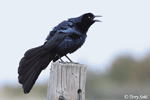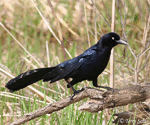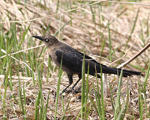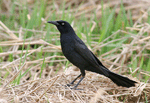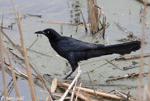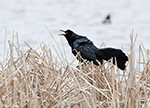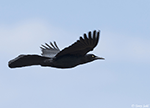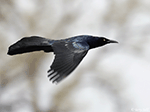Great-tailed Grackle
Quiscalus mexicanus
| Length: 15 to 18 inches | Wingspan: 18 to 24 inches | Seasonality: Summer |
| ID Keys: Extremely long fan-shaped tail, yellow eyes, even glossy black overall (male). Females very different plumage, brownish overall | ||
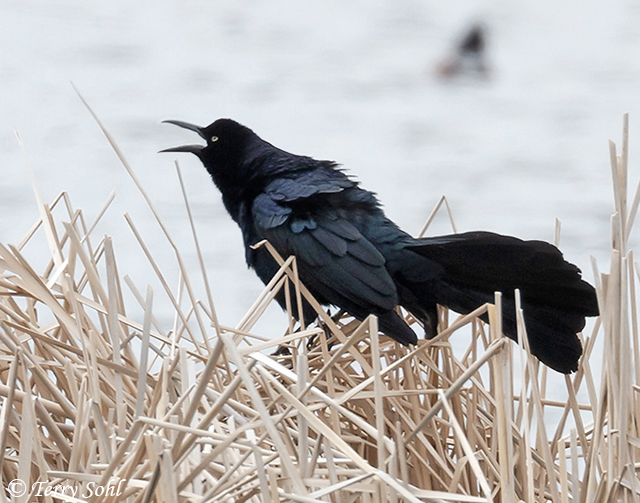 The Great-tailed Grackle
is a recent addition to the list of South Dakota birds, as this former specialty
of the Southwestern U.S. has been steadily expanding in numbers and range over
the last few decades. Gregarious birds, very large and noisy flocks can
sometimes be found, especially in their population strongholds further south and
west. Those found in South Dakota tend to be single birds or pairs. They are very similar in appearance to the
Boat-tailed Grackle, a species found
near in the Gulf and Atlantic coasts, but not found in South Dakota. They are
differentiated from the Common Grackle by
the obvious differences in the size and apparent volume of the tail.
The Great-tailed Grackle
is a recent addition to the list of South Dakota birds, as this former specialty
of the Southwestern U.S. has been steadily expanding in numbers and range over
the last few decades. Gregarious birds, very large and noisy flocks can
sometimes be found, especially in their population strongholds further south and
west. Those found in South Dakota tend to be single birds or pairs. They are very similar in appearance to the
Boat-tailed Grackle, a species found
near in the Gulf and Atlantic coasts, but not found in South Dakota. They are
differentiated from the Common Grackle by
the obvious differences in the size and apparent volume of the tail.
Habitat:
Can be found in a variety of open to semi-open habitats, including farmland, marshes and wetlands, brushy forest edges and hedgerows, and suburban areas. In South Dakota, they have primarily been observed in and around cattail marsh areas in the southeastern part of the state.
Diet:
Omnivorous. Food items may include any of the following: Insects, spiders, small fish, frogs, tadpoles, snails, crayfish, lizards, small snakes, eggs and young birds, waste grain, seeds, fruits, berries, and nuts.
Behavior:
Will forage nearly anywhere, from the ground, in shrubs and trees, and even by wading in shallow water. However, the majority of foraging is done on the ground. They also will sometimes follow or observe other birds and aggressively badger the bird and steal its food.
Nesting:
May and June. The hest is usually placed in dense vegetation near water, either in thick herbaceous marsh vegetation, or in small trees and shrubs near the water. The nest is a cup built of grasses, weeds, and marsh vegetation. The female lays 3 or 4 eggs, and she alone incubates the eggs. The female alone feeds and raises the young after they hatch. The young leave the nest after about 20 days.
Song:
An astonishing array of vocalizations can be heard from Great-tailed Grackles, from very loud, harsh cackles, to more subtle "squeaking" calls. The audio files below provide examples of some of the wide array of vocalizations that may be heard from the species.
1Click here to hear a song of a male Great-tailed Grackle, recorded in Baja California
2Click here to hear the chattering calls of a group of Great-tailed Grackles, recorded near Puerto Vallerta, Mexico
3Click here to hear different, "squeaky" calls from a group of Great-tailed Grackles, recorded in Denton County, Texas
4Click here to hear a mix of vocalizations of a Great-tailed Grackle, recorded in Honduras
Migration:
Those at the northern part of its range will migrate south in the fall. However, as the species expands its range to the north, it is now over-wintering in places it never used to winter. Not known to have over-wintered in South Dakota, however.
Interactive eBird map:
Click here to access an interactive eBird map of Great-tailed Grackle sightings
Similar Species:
Geographic range and other characteristics may help differentiate the following species, but overall appearance is similar enough that there could easily be confusion of Great-tailed Grackles with:
- Common Grackle - The "common" grackle species in South Dakota, found across the state and often in high numbers. Common Grackles are smaller than Great-tailed Grackles, with a shorter and less voluminous tail. The coloring on a male Great-tailed Grackle may share some of the iridescence of a Common Grackle when seen in the right light, but it often seems more uniform, while on a Common Grackle male, there often appears to be a demarcation between the iridescent head and neck and much of the rest of the body, almost like a large hood. Female Common Grackles are more similar in appearance to the males than are female Great-tailed Grackles, who are more brown overall.
- Boat-tailed Grackle - In the western Gulf coast from coastal Texas through Louisiana, both the Great-tailed and Boat-tailed Grackles may be present. Both are large grackle species with large tails that differentiate them from Common Grackles. An easy way to tell them apart is eye color, as Great-tailed Grackles have pale yellow eyes, while Boat-tailed Grackles have dark eyes.
- "Other" Blackbird species - From a distance, Great-tailed Grackles could potentially be confused with blackbird species such as Brewer's Blackbird, Rusty Blackbird, or Brown-headed Cowbird, given the dark overall body. However, these are all substantially smaller species, and if seen well, they all lack the long voluminous tail and the longer heavier bill of a Great-tailed Grackle.
Conservation Status:
Overall populations of Great-tailed Grackle are generally stable, and they may be increasing locally in parts of their range, particularly as their range has expanded northward somewhat in recent decades. They are found over a broad geographic area and there are no current threats to the overall popoulation. The IUCN lists the Great-tailed Grackle as a species of "Least Concern".
Bird Feeders:
Will attend feeders for various seeds and nuts.
South Dakota "Hotspot":
Great-tailed Grackles have expanded their range to include parts of South Dakota in the last 2 decades, but that expansion has been inconsistent, with birds present one year, and gone the next. The first place I ever saw Great-tailed Grackles was "Atkins Slough", an area just west of Tea (and now just west of where the Tea High School is). All other sightings I've had have been in the scattered wetlands in western Lincoln and Minnehaha counties.
Further Information:
1) BirdWeb - Great-tailed Grackle
2) Audubon Guide- Great-tailed Grackle
3) WhatBird - Great-tailed Grackle
Photo Information:
April 17th, 2005 -- Wetland near Tea -- Terry Sohl
Additional Photos:
Click on the image chips or text links below for additional, higher-resolution Great-tailed Grackle photos.
Audio File Credits:
1Manuel Grosselet, XC339893. Accessible at www.xeno-canto.org/339893
2Manuel Grosselet, XC376266. Accessible at www.xeno-canto.org/376266
3Edward Caillouet, XC443815. Accessible at www.xeno-canto.org/443815
4Alfonso Auerbach, XC291872. Accessible at www.xeno-canto.org/291872
| Click on the map below for a higher-resolution view |
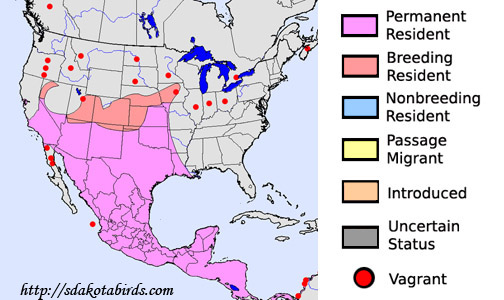 |
| South Dakota Status: Still a very uncommon summer breeder in South Dakota, primarily in the southeastern part of the state. Their range has expanded in recent decades, but presence in South Dakota has been inconsistent. Personal observation: They were easier to find earlier in the 2000s, then seemed to disappear for several years. Then in spring of 2019 I saw 2 in one day, in two different counties. |
Additional Great-tailed Grackle Photos
Click for a higher-resolution version of these photos
